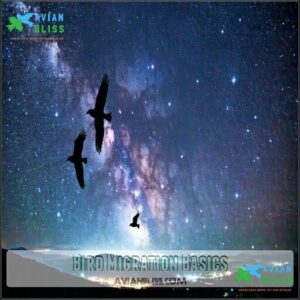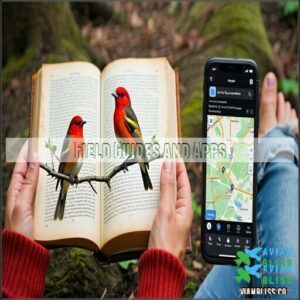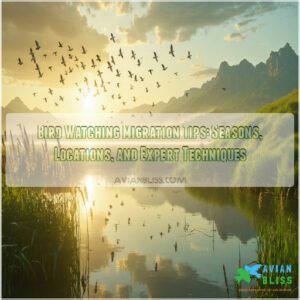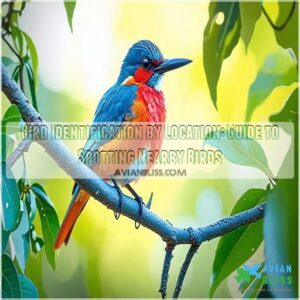This site is supported by our readers. We may earn a commission, at no cost to you, if you purchase through links.
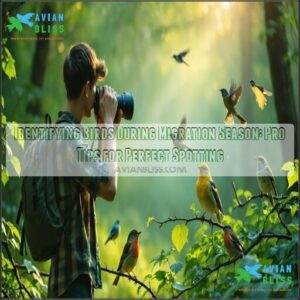
Focus on peak months—spring (March to May) and fall (August to October)—when species like warblers, geese, and thrushes pass through.
Use a reliable field guide or app to match key features like size, color, and markings. Learn their songs too; many migrating birds are easier heard than seen.
Head to hotspots like wetlands or forests, where you’ll find diverse species resting and refueling. Don’t forget binoculars—they’re your best friend for spotting distant flyers.
A little patience goes a long way, so stay observant and curious.
Table Of Contents
- Key Takeaways
- Bird Migration Basics
- Why Birds Migrate
- Best Time for Birdwatching
- Choosing Ideal Location
- Identifying Birds During Migration
- Essential Birdwatching Skills
- Conserving Migratory Birds
- Frequently Asked Questions (FAQs)
- What is the BIRDIST rule 10?
- How do birds know where to fly when they migrate?
- How do birds know when it is time to migrate?
- What guides birds during migration?
- How do weather conditions affect bird migration?
- Can birds get lost during long migrations?
- What are the most dangerous migration challenges?
- Do different bird species migrate together?
- How fast do migratory birds travel?
- How do urban environments affect migrating birds?
- Conclusion
Key Takeaways
- Focus on peak migration months (spring: March to May, fall: August to October) and visit hotspots like wetlands, forests, or coastal areas.
- Use binoculars, field guides, and apps to match features like plumage, size, and calls for accurate bird identification.
- Watch birds’ behaviors, such as feeding, flight patterns, or mating displays, to identify them quickly and effectively.
- Reduce environmental impact by staying quiet, respecting habitats, and supporting conservation efforts like protecting stopover sites.
Bird Migration Basics
You’ll spot more birds during migration by understanding the seasonal patterns that drive millions of birds to travel between breeding and wintering grounds.
Birds navigate these journeys using the sun, stars, Earth’s magnetic field, and mental maps, traveling thousands of miles to find food, suitable climate, and breeding opportunities, utilizing their innate ability to follow the stars.
Navigating immense journeys, birds rely on the sun, stars, magnetic fields, and mental maps to find food and secure survival.
Seasonal Journey Patterns
Birds’ seasonal journey patterns follow remarkable rhythms triggered by environmental cues like changing daylight hours and temperature shifts.
You’ll notice these migrations happening twice yearly as species travel between breeding and wintering grounds. Altitudinal migration occurs when birds move up and down mountains seasonally, while loop migrations create different outbound and return routes.
These trigger mechanisms showcase journey adaptability, with each species developing unique patterns based on their evolutionary history. Understanding these movements helps you better predict where and when to spot migrating birds, utilizing environmental cues.
Navigation Methods Used
While migrating birds journey across landscapes, they rely on sophisticated navigation methods to guide their travels.
You’ll be amazed at how these feathered travelers find their way:
- Solar Navigation: Using the sun’s position as a compass
- Star Compass: Orienting by celestial patterns at night
- Geomagnetism: Sensing Earth’s magnetic field through specialized cells
- Mental Maps: Memorizing landscape features and landmarks
- Sensory Cues: Detecting infrasound, polarized light, and even scents
Understanding these navigation methods enhances your bird identification skills during migration season.
Many birds also use olfactory cues for navigation, especially over oceans.
Importance of Migration
After learning how birds navigate their journeys, you’ll appreciate why these travels matter so much.
Migration offers a remarkable survival advantage in our changing world. When you’re identifying migrating birds, you’re witnessing nature’s solution to environmental challenges.
Witness the marvel of migration—nature’s ingenious response to environmental shifts, ensuring survival and ecosystem harmony.
These seasonal journeys maintain ecosystem balance, preserve genetic diversity, and help species adapt to climate change.
By understanding migration patterns and routes, you’ll also become better at spotting birds and recognize their vital conservation needs.
It’s nature’s perfect balancing act!
Why Birds Migrate
You’ll witness birds traveling thousands of miles twice yearly as they seek abundant food sources and ideal breeding conditions.
These remarkable journeys help birds avoid harsh seasonal weather while maintaining access to essential resources their survival depends on, which includes seeking abundant food sources.
Food Availability Factors
Three key food availability factors drive bird migration patterns.
When you’re identifying migrating birds, remember they’re basically following nature’s calendar of abundance.
Insect abundance peaks, seed production cycles, fruit ripening seasons, and nectar sources all determine when and where birds travel.
Birds track prey density across vast distances, instinctively knowing when food resources will be plentiful at their destination locations.
Breeding Opportunities
During migration season, birds journey toward prime breeding opportunities that guarantee their species’ survival.
You’ll notice dramatic changes in their behavior as reproduction becomes the priority.
- Males display vibrant plumage and complex songs for mate selection
- Birds engage in fierce territory defense to secure quality nesting sites
- Clutch size varies based on habitat quality and food availability
- Parental care strategies evolve to maximize nesting success
The behaviors exhibited during this period are crucial for the species’ continuation, highlighting the importance of prime breeding opportunities.
Climate Adaptation Strategies
Many birds have developed remarkable climate adaptation strategies to survive environmental changes.
You’ll notice these adjustments in their migration patterns and timing throughout the seasons.
| Adaptation Strategy | Example | Impact |
|---|---|---|
| Range expansion | Cardinals moving northward | New habitat utilization |
| Altered breeding | Earlier nesting cycles | Matching food availability |
| Food source changes | Switching preferred insects | Survival flexibility |
These shifting migration responses help preserve species as habitats transform during our changing climate.
Best Time for Birdwatching
You’ll find the richest bird diversity during dawn hours from mid-April to mid-May when spring migration peaks, with birds displaying vibrant breeding plumage and increased vocal activity.
Fall migration offers another prime viewing window from August to October, though exact timing varies by region and weather patterns, making spring migration a notable time for observation.
Spring Migration Peaks
When birds reach their seasonal zenith between mid-April and mid-May, you’ll witness nature’s most spectacular show.
This spring migration peak offers ideal identification opportunities as birds display most dazzling spring plumage changes and heightened vocal activity.
Early arrivals establish territories through song, while later migrants overlap with nesting behaviors.
Listen for distinctive calls and watch for colorful warblers, thrushes, and tanagers claiming their breeding grounds.
Consider visiting top birding locations for prime viewing.
Fall Migration Timing
While spring migration offers vibrant songbirds, fall’s parade brings different rewards.
Unlike spring’s concentrated rush, fall migration timing stretches from late August through November, with weather patterns substantially influencing movement.
You’ll notice regional differences—southern states see migrants earlier, while northern areas experience later departures.
Track species variation using BirdCast forecasts and local birding groups, as different birds follow distinct schedules.
Climate impact creates additional unpredictability, so monitor local conditions to catch those perfect peak windows.
Peak Migration Months
During peak migration months, you’ll witness nature’s greatest spectacle unfold before your eyes.
March to May (spring) and August to October (fall) offer prime viewing opportunities, with regional variations affecting timing. Weather influence and climate effects directly impact when birds pass through your area.
- BirdCast forecasts help you experience the magic of thousands of birds moving together
- Migration calendars reveal when specific species will arrive in your region
- Each migration season brings new identification challenges and discoveries
Choosing Ideal Location
You’ll substantially increase your chances of spotting diverse migratory birds by selecting locations where flight paths converge near water sources, forest edges, or elevation changes.
Strategic placement in these boundary zones allows you to observe species that might otherwise remain hidden, making your birdwatching experience more productive during peak migration periods, especially in areas with elevation changes.
Local Birding Hotspots
Urban birding, coastal hotspots, and wetland wonders stand out during migration season.
Local birding hotspots attract diverse species through varied habitats.
Check out this guide:
| Habitat Type | Diversity | Best Feature |
|---|---|---|
| Urban Parks | Medium | Convenient access |
| Coastal Wetlands | High | Rich feeding grounds |
| Conservation Areas | Very High | Protected migration routes |
Explore these sites for ideal birdwatching and bird identification success!
Researching Birding Trails
A well-planned birdwatching trip on migration-season trails can uncover remarkable sightings.
Start your research by evaluating key trail details:
- Trail accessibility: Confirm parking, path conditions, and seasonal closures.
- Trail difficulty: Match your fitness level to steepness and length.
- Permit requirements: Check if prior approval is needed.
- Route planning: Study maps to locate prime birding spots.
- Safety precautions: Bring weather gear and first-aid essentials.
Using birding forums, apps, and park websites deepens your understanding of bird migration patterns.
Consider purchasing detailed birding resources for ideal navigation.
Preparation boosts your chances of spotting elusive species while enjoying the adventure!
Considering Habitat Types
Understanding habitat types makes bird identification easier during migration season.
Coastal areas attract shorebirds, while forests shelter songbirds.
Grasslands support ground-dwellers, and urban habitats might host uncommon visitors.
Habitat diversity and resource availability shape these patterns.
Keep habitat degradation in mind—conservation strategies protect these niches.
Explore migration hotspots, matching bird habitats to species.
Nature aligns perfectly when you observe thoughtfully, considering the importance of conservation strategies.
Identifying Birds During Migration
To identify birds during migration, focus on key features like size, shape, and distinct plumage patterns.
Listen closely to their calls and observe behaviors like flight style and feeding habits for accurate identification, focusing on key features.
Visual Identification Techniques
Your eyes are your greatest asset when identifying birds during migration.
Focus closely using these visual identification techniques:
- Plumage Variations: Study unique plumage colors and wing patterns.
- Shape Analysis: Assess silhouettes for distinctive shapes or crests.
- Size Comparison: Match sizes with familiar species.
- Flight Patterns: Observe flapping rhythms or gliding styles.
- Habitat Clues: Watch for birds aligning with local vegetation.
These steps sharpen your ability to master bird identification quickly and confidently.
Using binoculars effectively requires understanding diopter adjustment techniques for ideal focus.
Auditory Identification Methods
After spotting a silhouette, tune in to nature’s symphony.
Identifying birds by sound—such as bird calls or songs—adds a powerful layer to birdwatching.
Apps like Merlin can analyze nocturnal flight calls effectively, aiding in bird song ID.
Pay attention to variations like mimicry detection or call notes specific to certain species.
Recording analysis helps filter background noise, uncovering distinct bird vocalizations.
By honing your auditory identification methods, you’ll discover incredible insights into migration season!
Behavioral Recognition Strategies
To master bird identification during migration, focus on their behavior patterns:
- Spot distinct flight patterns—they’re like unique signatures.
- Observe foraging behavior; different species feed differently.
- Study social interactions within flocks.
- Watch predator avoidance, like sudden dives or zigzags.
- Catch mating rituals—displays and calls stand out during migration.
These birdwatching tips will sharpen your skills to identify birds during migration.
Essential Birdwatching Skills
Mastering birdwatching skills lets you identify migratory birds with confidence and precision.
With the right tools, techniques, and a bit of patience, you’ll uncover the fascinating details that make each species unique.
Binoculars and Spotting Scopes
Looking to up your birdwatching game? Invest in binoculars with 8x or 10x magnification power and quality lens coatings for crystal-clear views.
A wide field of view helps track bird migration, while image stabilization keeps your sightings sharp. Spotting scopes add extra detail, especially for distant bird identification.
Consider specialized birding optics for superior viewing. Explore budget options, but don’t skimp on durability.
Clean and maintain your optics regularly—clear lenses make all the difference during migration season!
Field Guides and Apps
Choosing the right bird identification tool opens up a whole new world of birdwatching.
Bird field guides, paired with bird identification apps like Merlin and Audubon, offer offline functionality and advanced features.
App accuracy, paired with real-time guide updates, guarantees spotting the right species is hassle-free.
For finding helpful resources, consider exploring available birding products.
Check user reviews for the best tools suited to your needs.
These resources combine tradition and tech to enrich your birding adventures.
Patience and Persistence Techniques
A little patience goes a long way in birdwatching, especially during migration. To improve your chances of spotting and identifying birds in flight, focus on quiet observation and reducing your impact.
Move slowly and carefully, blending into the environment with stealth techniques. Capture your experiences with detailed notes to track patterns over time. These birdwatching tips make every outing more rewarding.
- Stay Still: Avoid sudden sounds or movements.
- Approach Quietly: Minimize your presence.
- Observe Behavior: Look for unique traits.
Conserving Migratory Birds
You can help migratory birds by protecting essential stopover sites and minimizing threats like habitat loss and light pollution.
These actions guarantee birds have safe places to rest and refuel on their long journeys, which is crucial for their survival, and by doing so, you support the conservation of migratory birds.
Protecting Stopover Sites
Stopover sites are like rest stops for birds, offering food, rest, and shelter during migration. Protecting these areas guarantees successful journeys along migration routes.
Here are impactful conservation strategies:
Small actions make a big impact on bird migration!
Reducing Light Pollution
Light pollution confuses migrating birds during the migration season, leading to collisions and exhaustion. You can help by reducing artificial lighting.
- Install shielded light fixtures to direct beams downward, minimizing sky glow.
- Switch to energy-efficient, amber-toned bulbs, which have less wildlife impact.
- Apply decals or netting on windows to prevent bird collisions.
- Support Dark Sky Initiatives to protect migratory pathways through community action.
These actions support effective bird conservation. Small efforts support conservation efforts greatly.
Supporting Conservation Efforts
Tackling light pollution leads naturally to broader conservation efforts.
Support bird conservation through habitat restoration, citizen science, and sustainable practices.
Join local cleanup events, report bird sightings for research, or advocate for policy changes protecting migratory birds.
Funding habitat conservation initiatives or engaging in education outreach inspires others to act, leading to thriving migration seasons and healthier ecosystems for generations.
Frequently Asked Questions (FAQs)
What is the BIRDIST rule 10?
Only about 10% of bird species are non-migratory, so understanding rules like BIRDIST Rule 10 helps.
It emphasizes practicing ethical birdwatching, like respecting birds’ habitats and keeping your distance to minimize stress or disruption.
How do birds know where to fly when they migrate?
Birds rely on natural cues like the sun, stars, Earth’s magnetic field, and mental maps.
Their instincts and genetic programming guide them across incredible distances, ensuring they find food, mates, and safe habitats.
How do birds know when it is time to migrate?
Ever feel nature’s clock ticking?
Birds do. They sense changes in daylight, temperature, and food availability, triggering their internal biological rhythms.
Hormones spike, signaling it’s migration time—a life-saving journey driven by instinct and environmental cues, guided by their internal biological rhythms.
What guides birds during migration?
Instinct, celestial navigation, and Earth’s magnetic field guide birds during migration.
They rely on the sun, stars, and even mental maps to stay on course, traversing vast distances with precision through changing landscapes and conditions.
How do weather conditions affect bird migration?
Shifting weather impacts migration through wind patterns, temperature, and storms.
Favorable winds help birds save energy, while rain or strong winds delay flights.
Temperature changes trigger movement, pushing birds toward food and safer environments, with storms being a significant factor.
Can birds get lost during long migrations?
Even the best-laid plans can go awry—birds sometimes get lost during migration due to storms, disorientation, or geomagnetic shifts.
Still, their instincts and natural cues usually guide them back on track, which is a complete testament to their resilience.
What are the most dangerous migration challenges?
Birds face dangers like storms, habitat loss, and exhaustion during migration.
Predators, scarce food, and disorientation from light pollution or geomagnetic changes also threaten them.
These challenges test their endurance and survival instincts.
Do different bird species migrate together?
Some bird species migrate together, forming mixed-species flocks for safety and efficiency.
These groups often include birds with similar flight speeds or habitats, like warblers and vireos, using numbers to reduce predator risks and improve navigation.
How fast do migratory birds travel?
Migratory birds can zip along at speeds of 15 to 50 miles per hour, depending on the species and conditions.
Tailwinds boost their pace, while longer flights often combine steady flapping and soaring to conserve energy.
How do urban environments affect migrating birds?
Urban environments act like obstacle courses for migrating birds, disrupting their paths with bright city lights, reflective windows, and reduced green spaces.
These challenges can disorient birds, causing collisions or exhaustion, but small changes can help, and addressing these issues can potentially save many birds from collisions.
Conclusion
Think of identifying birds during migration season as piecing together a living puzzle.
Use your tools—binoculars, field guides, and apps—to match colors, markings, and sounds.
Visit diverse habitats like forests or wetlands during peak months and stay patient.
Pay attention to their behavior and listen closely, as many birds announce themselves before they’re visible.
By sharpening your observation skills and choosing prime locations, you’ll uncover the beauty and complexity of these seasonal journeys effortlessly.
Stay curious!
- http://blog.aba.org/2012/02/abarare-pink-footed-goose-maryland.html
- http://birdcast.info/forecasts/
- http://ebird.org/content/canada/news/ron-pittaways-winter-finch-forecast-2015-2016/
- https://rachelcarsoncouncil.org/awe-mystery-bird-migration/
- https://www.perkypet.com/advice/bird-watching/bird-migration-facts/timing

